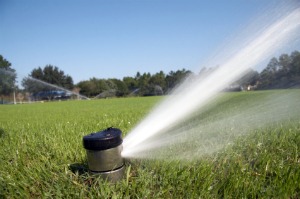When you take a sensible approach to lawn watering…
Your neighbors — who water every day — will wonder why your lawn is so green and their water bills are so high.
Many homeowners over-water, I see it every season and in every neighborhood. They set and forget their automatic sprinkler system to water every other day–or every day–wasting water and unknowingly reducing the health of their landscape. If you’re using an old automatic irrigation timer, it’s time to upgrade to a Smart Sprinkler Controller. No more watering on rainy days!
Watering your lawn to supplement rainfall, encourage deep rooting, and conserve water is key to a sustainable lawn care program.
Your fall and spring lawn care program should focus on maximizing root volume and depth to prepare for summer drought. Mowing high, aerating, fall nitrogen fertilization (cool-season lawns) summer fertilization (warm-season lawns), and dethatching are some things you can also do to encourage deep rooting.
What we cover
ToggleLawn Watering Rules of a Green-Thumb

- Determine if you need to water your lawn — Consider the weather, time of year, and grass type.
- Irrigate deep and infrequent to encourage deep, strong roots.
- Water your lawn to ensure adequate moisture — Adding 1 to 1 1/2″ per week minus any rainfall.
- Save water by irrigating in the early morning hours.
- Adjust sprinkler heads to avoid watering the driveway, sidewalk or road.
Does your lawn need to be watered?

When thinking about watering…grass type, time of year, and weather, will help you decide. To conserve water — wait until the grass begins to show signs of stress from lack of water (wilt).
Ideally, the grass plants should dictate your lawn watering needs. Your grass is telling you it’s “thirsty” when you see wilt or footprinting. It’s wilting when the color changes from its normal green to a shiny purple/bluish color. Footprinting is when you leave visible footprints after walking across your lawn. If your footprints remain for an extended period of time, the lawn needs to be watered.
The type of grass in your lawn also helps to determine lawn watering needs. Some grass types are more drought tolerant than others… perennial ryegrasses have little tolerance to dry conditions, while fine fescues tolerate dry periods quite well. Cool-season grasses usually need more moisture than warm-season grasses in stressful summer conditions.
Don’t start watering too early in spring and keep watering late into the fall. It’s tempting to start watering in early spring. However, there is usually enough rain in early spring to keep your lawn looking good. By waiting until the weather turns hot and dry, you’ll encourage deep rooting and prepare your lawn for the dog days of summer. It’s also a good idea to water into the fall to keep moisture in the ground through the winter.
Watching the weather will help you plan your irrigation schedule. Your lawn uses a lot of water during sunny, hot, windy days with low relative humidity. If there is rain in the forecast, you might want to let nature do the watering for you.
How much water does your lawn need?

Irrigate deep and infrequent to encourage deep, strong roots. Ideally, you’ll keep the soil moist to a depth of 5 or 6 inches. Watering two or three times a week is better than watering every day. Daily irrigation causes shallow roots and extra stress on your grass plants.
Adding 1 to 1 1/2 inches of rain per week– minus any rainfall – will keep your lawn green and healthy. This is the general amount. Your climate and grass type determine how much water your lawn needs.
How to Set Your Sprinkler System
Calibrate your sprinkler system so that you know how long to run each zone. This will also work if you use a hose-end sprinkler.
How to calibrate your irrigation system.

For each zone:
- Place 5 to 10 straight-sided containers at random throughout the zone
- Run the zone for 15 minutes
- Measure the depth with a ruler
- Average the amounts
- Multiply by 4 tells you how much water per hour

For example…
You want to water for three days and apply 1 1/2″ per week.
After running zone 1 for 15 minutes, the average amount caught in the pans was 1/4″. You would need to run this zone for 90 minutes to get 1 1/2″ of water. So you would program this zone to run 30 minutes on watering days.
Over-watering…
- Is wasteful and results in high water bills
- Causes excessive growth and extra mowing
- Encourages weeds and summer fungal diseases
- Increases the risk of fertilizer and pesticide runoff
Efficient Lawn Watering

Irrigate in the early morning hours (between 4 – 8 am). The weather is usually cool and calm so water loss from evaporation is minimized. If you are on a municipal water supply…water demand is low in the early morning.
Monitor and adjust your sprinkler heads. Look for clogged nozzles and over-spray. A tuned sprinkler system will spread water on your lawn evenly, keeping it off your driveway, sidewalk and road.
More Essential Lawn Care Practices:
How to choose the best lawn fertilizer. What do the numbers on the bag mean? Are organic fertilizers more eco-friendly than chemicals? Consider costs and nutrient needs. Are they pet-safe?
Lawn Mowing: Tips and techniques, the basics of lawn care. How to cut grass like a pro. Cutting grass to keep it looking groomed and healthy. DIY tips and advice for growing grass.
Use this fertilizer calculator to determine the amount of granular fertilizer product that is needed to spread on your lawn according to recommended rates.
